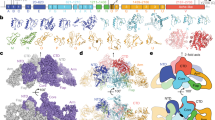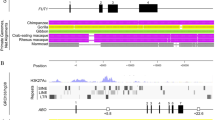Abstract
Thy-1 is a differentiation marker expressed predominantly on thymocytes, T cells and brain tissue1. Its presence on murine peripheral T cells but not B cells has long been used to distinguish between these two populations of lymphocytes2. Although analogues of Thy-1 have been described in several mammalian species3–6, its tissue distribution in different species varies widely7,8, precluding its use as T-cell-specific marker. The Thy-1 molecule is a cell-surface glycoprotein of relative molecular mass 18,000, one-third of which represents carbohydrate9; the protein moieties of the rat and murine Thy-1 molecules10 have been sequenced and found to consist of 111 and 112 amino acids, respectively. An unusual aspect of Thy-1 is the apparent absence of a hydrophobic segment comparable to that observed in other membrane gly-coproteins which would allow integration of Thy-1 within the membrane lipid bilayer. This has prompted speculation that Thy-1 is anchored to the cell surface by some other hydrophobic component such as glycolipid. Here we report the structure of thy-1 complementary DNA and genomic clones and describe the exon-intron organization of the gene. More importantly, our data indicate that Thy-1 is initially synthesized as a molecule of 142 amino acids, 31 amino acids longer at the carboxyl end than the Thy-1 molecule isolated and characterized by Campbell et al11. An extremely hydrophobic region of 20 amino acids lies within this 31-amino acid stretch and may represent the transmembrane segment responsible for anchoring Thy-1 to the cell membrane.
This is a preview of subscription content, access via your institution
Access options
Subscribe to this journal
Receive 51 print issues and online access
$199.00 per year
only $3.90 per issue
Buy this article
- Purchase on Springer Link
- Instant access to full article PDF
Prices may be subject to local taxes which are calculated during checkout
Similar content being viewed by others
References
Reif, A. E. & Allen, J. M. Nature 209, 521–523 (1966).
Rail, M. C. Transplantn Rev. 6, 52–80 (1971).
Douglas, T. C. J. exp. Med. 136, 1054–1062 (1972).
Letarte-Muirhead, M., Acton, R. T. & Williams, A. F. Biochem. J. 143, 51–61 (1974).
Ades, E. W., Zwerner, R. F., Acton, R. T. & Balch, C. M. J. exp. Med. 151, 400–406 (1980).
McKenzie, J. L. & Farbre, J. W. Transplantation 31, 275–282 (1981).
Dalchau, R. & Fabre, J. W. J. exp. Med. 149, 576–591 (1979).
Crawford, J. M. & Goldschneider, I. J. Immun. 124, 969–976 (1980).
Morrison, M. H., Chaney, W. G. & Esselman, W. J. Molec. Immun. 21, 405–413 (1984).
Williams, A. F. & Gagnon, J. Science 216, 696–703 (1982).
Campbell, D. G., Gagnon, J., Reid, K. B. M. & Williams, A. F. Biochem. J. 195, 15–30 (1981).
Moriuchi, T., Chang, H. C., Denome, R. & Silver, J. Nature 301, 80–82 (1983).
Maxam, A. M. & Gilbert, W. Meth. Enzym. 65, 499–560 (1980).
Chirgwin, J. M., Przybyla, A. E., MacDonald, R. J. & Rutter, N. J. Biochemistry 18, 5294–5299 (1979).
Author information
Authors and Affiliations
Rights and permissions
About this article
Cite this article
Seki, T., Moriuchi, T., Chang, HC. et al. Structural organization of the rat thy-1 gene. Nature 313, 485–487 (1985). https://doi.org/10.1038/313485a0
Received:
Accepted:
Issue Date:
DOI: https://doi.org/10.1038/313485a0
This article is cited by
Comments
By submitting a comment you agree to abide by our Terms and Community Guidelines. If you find something abusive or that does not comply with our terms or guidelines please flag it as inappropriate.



